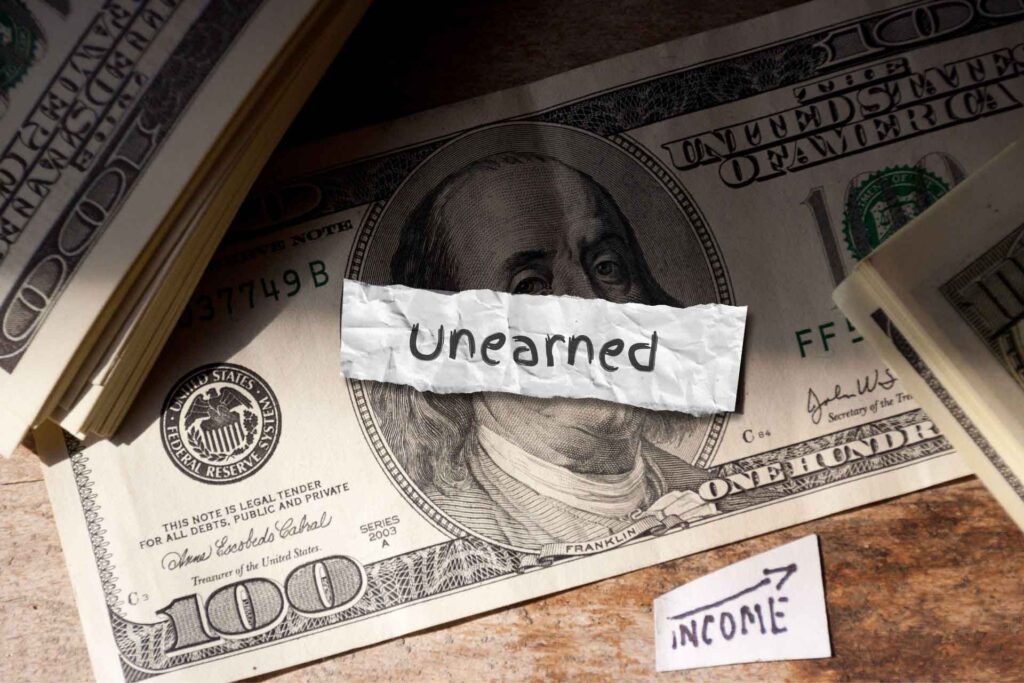Unearned income is a term that often surfaces in financial discussions, yet its nuances and implications are not always clear to most people.
In this article, we’ll delve into the depths of unearned income, providing you with a thorough understanding of what it entails, how it differs from earned income, examples, tax implications, and the various avenues through which individuals can receive unearned income.
What is Unearned Income?
It refers to money received by an individual without actively participating in a job or business that generates this income. Unlike earned income, which is the compensation for one’s labor or services, unearned income is not directly linked to work efforts.
Understanding unearned income necessitates an exploration of the varied channels through which individuals can channel wealth into their financial coffers, steering away from the more traditional models that exclusively tie financial prosperity to the grindstone of active, daily work.
What are examples of unearned income?
Unearned income, a pathway to financial freedom, unfolds in various forms, painting a picture of wealth creation beyond the usual work-for-pay scenario. Let’s explore some examples that highlight the versatility of unearned income, showcasing how money can flow in without the need for daily toil.
1. Investment Dividends:
One of the examples is the steady flow of dividends from investments.
When individuals invest in stocks, they become partial owners of the underlying companies. As these companies turn profits, a portion is distributed among shareholders in the form of dividends.
2. Interest from Financial Instruments:
The financial landscape boasts various instruments like bonds and certificates of deposit that offer interest payments to investors. You lend money, and it comes back with more over time. It’s a hands-off form of income.
3. Capital Gains:
Sell something valuable, like a house or stocks, and make a profit. This profit, called capital gains, isn’t tied to your daily job. It’s a one-time reward for your investment.
4. Rental Income from Real Estate:
If you own property and rent it out, you get paid without actively managing it every day. It’s like having a money tree that doesn’t need constant attention.
5. Royalties from Creative Work:
Think of royalties as a payday for creative minds. Authors, musicians, or inventors earn money whenever their work is used or sold. It’s an ongoing reward for past efforts.
6. Retirement Income:
After years of working, retirement brings in money from sources like pensions or Social Security. You’re not working actively, but you still receive income.
7. Lottery or Gambling Winnings:
While unpredictable, winning a lottery or gambling is an example of unearned income. It’s luck, not work, that brings in a windfall.
These examples show that money can come from various avenues beyond a regular job.
The Difference Between Unearned Income and Earned Income:
As we’ve already explained what is an unearned income, Earned income is the monetary reward derived from active participation in work or services. In simpler terms, it’s the money you receive in exchange for your time, skills, or labor.
Some examples of earned income are salaries, wages, bonuses, and commissions earned through employment fall under this category.
Key Differences:
- Active vs. Passive: Earned income demands active involvement in a job or service, while unearned income is passive, requiring little to no daily effort.
- Time Dependency: Earned income often correlates with time spent working, measured through hours, days, or projects. Unearned income, however, isn’t bound by time constraints, providing flexibility.
- Risk and Reward: Unearned income, particularly from investments, carries a degree of risk. The potential for higher returns comes with the chance of losses. Earned income is generally more stable but may have a capped growth potential.
Understanding this dichotomy is crucial for financial planning. While earned income is the bedrock of most people’s financial stability, incorporating unearned income diversifies and fortifies your economic standing, creating avenues for sustained wealth growth.

Also Read: What is Considered Upper Class Worldwide
Do You Pay Taxes on Unearned Income?
Unearned income is generally subject to taxation, and it’s important to understand the tax implications associated with it various types. Here’s a detailed look at this aspect:
Taxation of Unearned Income:
Unearned income is often taxed differently than earned income. Common types of it, such as interest, dividends, capital gains, and rental income, are typically subject to taxation. The tax rates can vary based on the specific type of income and the individual’s overall tax situation. However, some types like gifts or certain inheritances, may not be subject to income tax.
Tips to Minimize Tax Liability on Unearned Income:
While unearned income is taxable, there are strategies to potentially minimize tax liability:
1. Tax-Efficient Investments:
Choose tax-efficient investment options. Some investments may offer lower tax rates on dividends or capital gains, helping to reduce your overall tax burden.
2. Tax-Advantaged Accounts:
Contribute to tax-advantaged accounts, such as IRAs (Individual Retirement Accounts) or 401(k)s. Investments within these accounts can grow tax-deferred or, in the case of Roth accounts, potentially tax-free.
3. Tax Loss Harvesting:
Implement tax loss harvesting strategies. Offsetting capital gains with capital losses can help reduce the taxable portion of your overall unearned income.
4. Hold Investments for the Long Term:
Consider holding investments for the long term. Capital gains on investments held for more than one year may qualify for lower tax rates.
5. Utilize Deductions and Credits:
Take advantage of deductions and credits. Some expenses related to investments or certain types of income may be deductible, reducing your taxable income.
6. Gifts and Inheritance Planning:
Explore gifting and inheritance planning. Properly structured gifts and inheritances may have different tax implications, and understanding these can help in managing tax liability.
7. Tax Planning Services:
Consult with tax professionals for personalized advice. Tax laws can be complex and subject to change, so seeking professional guidance can ensure you make informed decisions aligned with your financial goals.
It’s crucial to note that tax laws can vary by jurisdiction, and individuals should stay informed about the latest regulations. Developing a comprehensive tax strategy, considering both earned and unearned income, can contribute to effective financial planning and tax management.
How Do You Know If You Have Unearned Income?
Identifying unearned income involves recognizing money that comes your way without direct work efforts. If you have ever invested in stocks, lent money or deposited it in a bank, or any of the examples mentioned earlier, you likely have unearned income.
Also Read: Salary Negotiation Strategies: Maximize Your Earning Potential (3 Pitch Examples)
Ways You can start Receiving Unearned Income:
Generating unearned income involves using various channels. Here are some ways through which a person can start receiving unearned income:

1. Investment Portfolio:
Build a diversified investment portfolio. Invest in stocks, bonds, mutual funds, or real estate. Earnings from these investments, such as dividends, interest, or capital gains, constitute unearned income.
2. Real Estate Investments:
Purchase property for rental purposes. Monthly rental income becomes a steady source of unearned income.
3. Savings and CDs:
Put money in high-yield savings accounts or certificates of deposit (CDs). Interest earned on these savings is a form of unearned income.
4. Peer-to-Peer Lending:
Engage in peer-to-peer lending platforms. By lending money to individuals or small businesses, you can earn interest, contributing to your unearned income.
5. Intellectual Property:
Create and monetize intellectual property. If you have patents, copyrights, or trademarks, license them to others for a fee, generating unearned income.
6. Dividend-Paying Stocks:
Invest in stocks that pay dividends. Regular dividend payments from well-established companies contribute to your unearned income.
7. Royalties from Creative Work:
If you’re an artist, writer, musician, or creator, earn royalties from your creative work. This can be through book sales, music streaming, or licensing agreements.
Also Read: Why You Should Steer Clear Of The 6-Figure Myth When Starting Out
Whether it’s dividends from investments, rental income from properties, or retirement benefits, unearned income plays a significant role in shaping individuals’ financial landscapes.
By grasping the intricacies of unearned income, individuals can make informed decisions to optimize their financial well-being.



